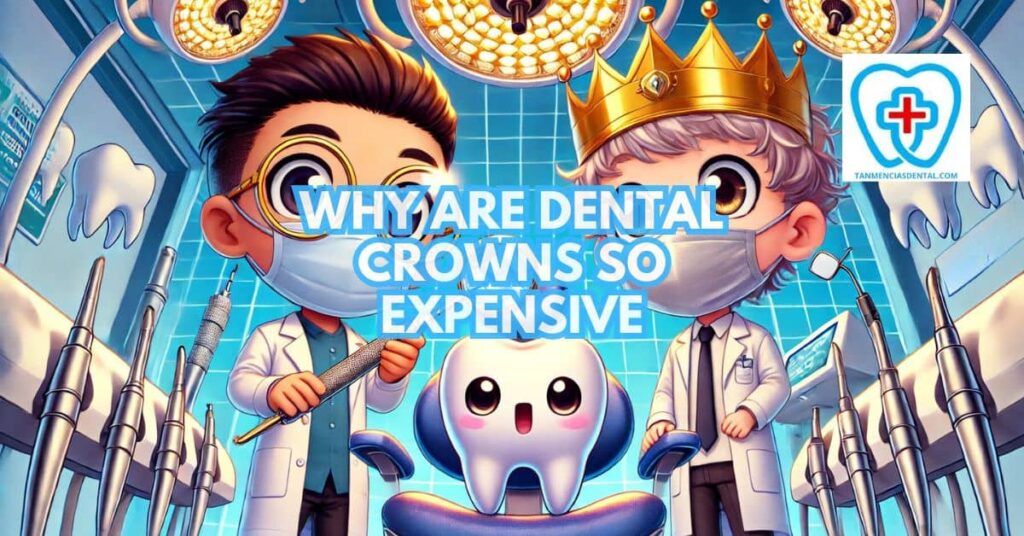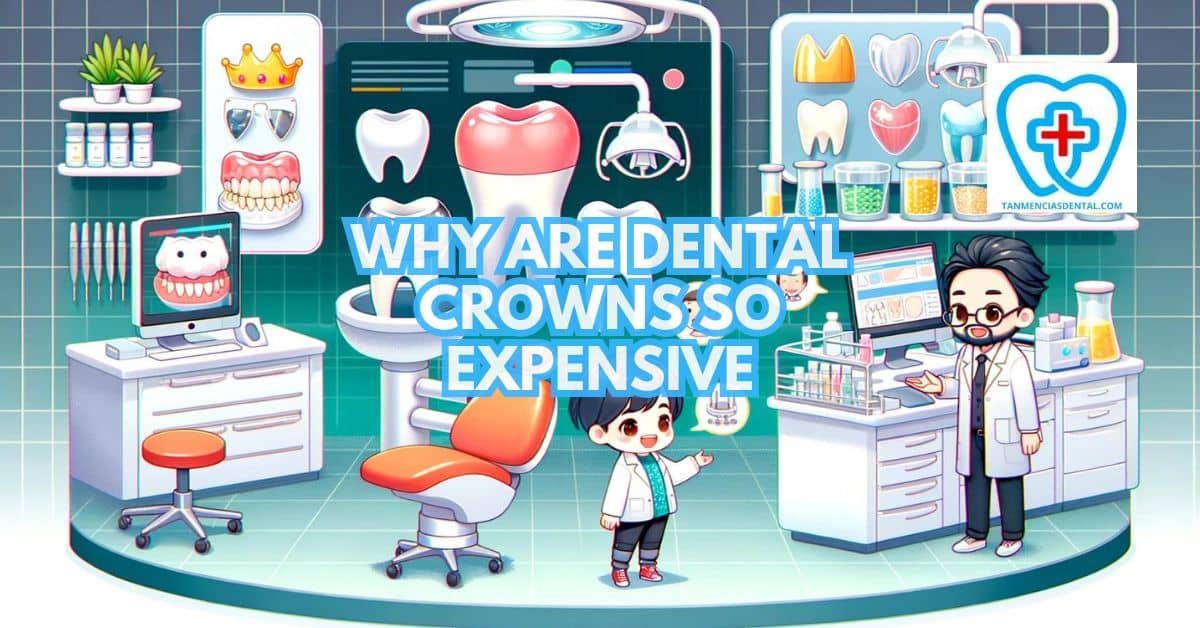Dental crowns are essential for protecting and restoring damaged or decayed teeth.
They are carefully crafted to fit snugly over the visible part of a tooth, ensuring both functionality and a natural appearance.
Many people wonder, “Why are dental crowns so expensive?”
The high cost of dental crowns is influenced by factors such as the materials used, the advanced technology required, and the expertise of dental professionals.
Understanding these reasons can help patients appreciate the value and long-term benefits of investing in a quality dental crown.
1. Material Matters: Why Some Crowns Cost More
Dental crowns are available in a variety of materials, including porcelain, ceramic, metal, and composite resin, each suited to different needs and budgets.
The type of crown you choose can significantly affect the overall cost, as some materials are more specialized and expensive to produce.
Porcelain and ceramic crowns are valued for their ability to resemble natural teeth in translucency and color, making them an ideal choice for visible front teeth, but they are often more expensive.
In contrast, composite resin crowns are generally less expensive and can be a good option for those seeking a temporary or budget-friendly solution.
Metal crowns, including those made from gold or zirconia, provide exceptional durability and are often used for molars, which require greater strength to withstand chewing forces.
However, these materials are costly and less likely to match the natural appearance of teeth.
Balancing the benefits of durability, aesthetics, and cost is crucial when selecting the right type of crown for your dental needs.
🦷 Overcoming Challenges with Dental Cleanings and Braces
2. Durability and Long-Term Savings
Different crown materials have varying lifespans, which affects their overall cost.
Stronger materials like gold or zirconia may cost more initially but last much longer than cheaper alternatives.
This durability means you won’t need to replace your crown as often, saving money over time.
Investing in a long-lasting crown can reduce the need for additional dental treatments in the future.
Overall, choosing a durable material can be more cost-effective in the long run.
🦷 How to Choose the Right Dentist for Your Kids
3. The Lab Factor: Behind-the-Scenes Work Adds Up
Creating a crown involves detailed and skilled labor in a dental laboratory.
Dental technicians must take exact measurements from molds or digital scans provided by the dentist to craft a crown that fits perfectly and meets specific aesthetic requirements.
This process involves several stages of casting, molding, and sometimes hand-carving, which can take hours of meticulous work.
The equipment used in these labs is also highly specialized, adding to the overhead costs of the dental practice.
Since each crown is custom-made, the lab work becomes a significant part of why crowns are priced higher than simpler dental procedures.
🦷 Oral Surgery vs. General Dentistry: Key Differences
4. Dental Expertise: A Skilled Dentist Makes a Difference
The role of a dentist in the process of fitting a dental crown is critical.
Dentists with specialized training in prosthetic dentistry possess skills that ensure a crown not only fits well but also looks natural and functions effectively.
The years of training and ongoing education to stay updated with the latest techniques contribute to the cost of their services.
Additionally, a dentist’s experience can reduce the risk of complications, such as poor fit or infection, which might result in additional costs down the line.
The expertise of the dentist, therefore, is a cornerstone of the crown’s value, making their high fee part of the overall expense.
🦷 Tooth Restoration in Marikina: Get Your Confident Smile Back

5. High-Tech Dentistry: Advanced Tools Come at a Cost
The integration of advanced technology into dental practices has transformed how dental crowns are designed and manufactured.
Technologies such as digital imaging and 3D printing allow for more precise and faster production of crowns but come with high acquisition and maintenance costs.
These tools provide significant benefits, including reduced error rates and less invasive procedures, which ultimately enhance patient comfort and outcome.
However, the investment in cutting-edge technology is a substantial contributor to the overall costs of dental procedures, including crowns.
Dental practices that offer these advanced options typically charge more to offset the costs of the technology.
🦷 What to Look for in a Family Dental Care Provider
6. Multiple Crowns: Multiplying the Expense
Patients requiring multiple crowns face considerably higher costs.
Each crown incurs its own set of expenses related to materials, lab work, and the dentist’s time.
When multiple teeth need crowning, these costs accumulate, reflecting a larger total expense.
Furthermore, the complexity of coordinating the treatment for several crowns can extend the amount of time required for both preparation and application, which in turn increases the labor costs.
This scenario is often seen in full-mouth reconstructions or when multiple teeth have been damaged due to trauma or decay.
🦷 Why Children’s Orthodontic Care Matters
7. Location, Location, Location: Geographic Price Variations
The cost of dental crowns varies significantly across different regions due to variations in the cost of living, labor charges, and even local regulations.
In urban areas, where the cost of operating a dental practice is generally higher, patients might notice an increase in prices.
Conversely, in less populated areas, dental services might be cheaper, but the availability of advanced technology and specialized services could be limited.
These geographic disparities affect how much dentists charge for crowns, influencing their overall affordability for patients.
Patients may find it beneficial to compare prices across different areas if they have the flexibility to do so.
🦷 Key Questions for Your Dentist Before a Tooth Extraction
8. Insurance: Understanding Your Coverage for Crowns
Navigating dental insurance can be complex, especially since coverage for crowns can vary greatly between different policies.
Most insurance plans cover a portion of the cost of a crown, typically under the category of major restorative care, but they often do not cover the total expense.
It’s important for patients to understand their insurance benefits, including deductibles, copayments, and yearly maximums, which all affect out-of-pocket costs.
In addition, some insurers might only cover certain types of materials or procedures, which can limit options or result in higher costs if a patient prefers a non-covered type.
Communicating with both the dental office and the insurance provider is essential to maximizing benefits and minimizing surprises in costs.
🦷 Is Your Nighttime Routine Hurting Your Smile?
9. When Things Get Complicated: Additional Procedures Drive Up Costs
Often, the need for a dental crown is accompanied by other dental issues that require preliminary treatments.
Procedures like root canals, dental implants, or treatment for gum disease may be necessary before a crown can be effectively placed.
These additional treatments add layers of complexity and increase the total cost significantly.
Each of these procedures involves its own set of materials, time, and expertise, which contribute to the overall expense.
Ensuring the tooth and surrounding structures are healthy is crucial for the longevity of the crown, making these preliminary procedures indispensable despite their impact on cost.
🦷 Finding the Best Pediatric Dentist in Marikina
10. The Smile Factor: Cosmetic Considerations and Premium Materials
For many patients, the appearance of dental crowns is just as important as their functionality.
Crowns that are placed on the front teeth require a high level of aesthetic consideration to ensure they blend seamlessly with the rest of the teeth.
This often involves the use of high-end materials like porcelain or ceramic, which are praised for their natural appearance but are more costly.
Plus, the process of matching crowns to the natural color of adjacent teeth can require time-consuming techniques and multiple adjustments.
Cosmetic excellence in dental crowns therefore drives up the price due to the premium materials and extra labor involved.
🦷 Top Pediatric Dental Care Tips for Happy Kids
11. Beyond the Initial Cost: Consultations and Follow-Up Visits
The expense of dental crowns is not confined to the procedure alone.
Initial consultations to evaluate the need for a crown, as well as the detailed planning of the procedure, are part of the process.
Follow-up visits after the crown has been placed are crucial to ensure proper fit and function and to make any necessary adjustments.
These appointments, though minor, involve additional time and resources from the dental practice.
They are essential for patient satisfaction and the long-term success of the dental crown, thus contributing to the cost.
👨⚕️ Conclusion
Understanding the multifaceted reasons behind the high cost of dental crowns can alleviate some of the initial sticker shock experienced by many patients.
From the sophisticated materials and technologies used to the extensive expertise required to properly place them, each factor plays a critical role in pricing.
Moreover, the additional procedures and follow-up care ensure the effectiveness and durability of the treatment, representing a long-term investment in one’s oral health.
While the upfront cost may be significant, the benefits of having a functional, aesthetically pleasing, and long-lasting dental crown justify the expense.
By appreciating the complexity and necessity of these components, patients can recognize the true value offered by dental crowns in both dental restoration and cosmetic enhancement.
😊 Self-Promotion
At Tan-Mencias Dental Clinic in Parang, Marikina City, we’re dedicated to providing top-notch dental care with a smile!
Whether you’re considering a routine checkup or need a more comprehensive dental procedure, our friendly team is here to assist you.
Feel free to give us a call at 9171451074, send a message via our Facebook page, or reach out through our website’s contact form with any questions or to schedule an appointment.
We pride ourselves on making each visit to our clinic a comfortable and positive experience.
Let us take care of your smile with the expert care it deserves!

